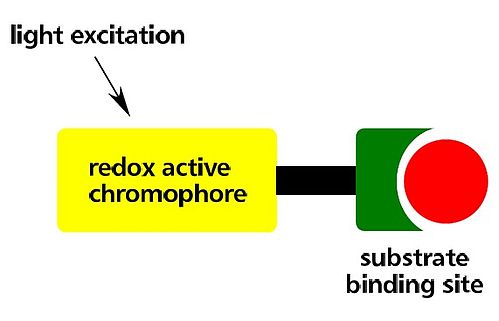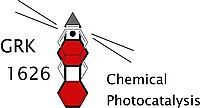
Chemical Photocatalysis
Chemical Photocatalysis
Using visible light for (enantio)selective organic transformations
We develop selective chemical photocatalysts for endothermic or kinetically hindered organic reactions and describe the key parameters of their design and function. This will pave the way to a broader use of solar energy for chemical transformations.
The photocatalysts consist of a redox active chromophore (sensitizer) and a catalytic unit or substrate binding site. Irradiation with light induces a charge separation between the electron donor and the electron acceptor unit of the photocatalyst, which is coupled to a subsequent chemical reaction. The charge separation may occur within the photocatalyst or between the photocatalyst and a bound substrate. The absorbed light energy contributes to the overall energy balance of the reaction and is thereby transformed into chemically stored energy or substitutes reagents, which are otherwise necessary to achieve conversion.
Although the physical primary steps of a photocatalysis are considered to be well understood, a description of electron transfer is provided by the Marcus-theory and mechanisms of catalysis are thoroughly investigated, a rational design of efficient photocatalysts is still very difficult: To achieve an effective photocatalysis the exact kinetic, energetic and geometric coupling of electronic and chemical steps is necessary.
Catalyses involving one electron transfer processes, such as radical cyclizations, or two electron transfer processes, e.g. two coupled redox transformations, are investigated in interdisciplinary research projects. Whenever possible, the visible part of the solar light spectrum is used as energy source. The structures of the photocatalysts are systematically varied and thermodynamic and kinetic key parameters are determined.
We expect from the detailed spectroscopic analysis and theoretical description of the photoreactions a better understanding of the important and general parameters describing an effective coupling of primary photo processes and subsequent chemical reactions. Model systems of biological photosynthesis and photovoltaic devices are explicitly excluded from the research program.



